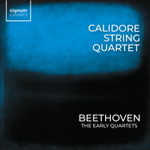
Welcome to Hyperion Records, a British classical label devoted to presenting high-quality recordings of music of all styles and from all periods from the twelfth century to the twenty-first.
Hyperion offers both CDs, and downloads in a number of formats. The site is also available in several languages.
Please use the dropdown buttons to set your preferred options, or use the checkbox to accept the defaults.

| Calidore String Quartet» More |
But the work as whole cannot lose its fascination. Nothing could be more exhilarating than the powerfully sprang first movement with its spare textures and the abrupt and economical nature of its harmonic movement. As in the A major Quartet, both halves have to be repeated if the dancelike character is to be properly stressed. This exuberant piece is followed by a soberly ornate slow movement in E fiat, with touches of mystery here and there, serving to relieve the general tone rather than to search depths.
One of Beethoven's most astonishing scherzos follows. Its remarkable rhythmic disruptions could have occurred at any time in his life, and if this piece had cropped up in one of the late quartets nobody would have questioned it. The Trio displays a wild and difficult violin solo, a phenomenon we find also in the trios of Opp 130 and 135.
A slow introduction, 'La Malinconia', full of daring shifts of harmony and texture, begins the last movement. It is justly one of the most celebrated passages in early Beethoven — he asks for it to be played with the greatest delicacy. It recurs later in the course of the following cheerful major movement, which may possibly have its origin in one of Haydn's weaker finales, the one in the 'Sunrise' Quartet, Op 76 No 4, of which the surprising and (for Haydn) rare helplessness is not improved upon by Beethoven. Maybe Beethoven's cheerfulness should not be thought of as a cure for the melancholy — perhaps it is part of it, with its sense of helpless circling. But we must avoid special pleading. Whatever we may feel about the conclusion of the B flat Quartet, the whole is a work of genius.
from notes by Robert Simpson © 1990
Mais dans l'ensemble l'ouvrage ne perd rien de sa fascination. Rien ne peut être plus grisant que le puissant premier mouvement avec sa trame frugale et la nature abrupte et économique de son mouvement harmonique. Comme dans le quatuor en la majeur, les deux moitiés doivent être répétées pour que l'allusion à la danse soit correctement exprimée. Ce passage exhubérant est suivi d'un mouvement lent et sobre en mi bémol, avec des pointes de mystère çà et là, dont le but est d'alléger le ton général plutôt que de rechercher des profondeurs.
Vient ensuite un des plus étonnants scherzos de Beethoven. Il aurait pu composer ces syncopations à n'importe quel moment de sa vie, et si ce passage était apparu dans un des quatuors ultérieurs, il n'aurait causé aucune surprise. Le Trio contient un solo de violon sauvage et difficile, phénomène que nous retrouvons dans les trios des opus 130 et 135.
Le dernier mouvement commence par une lente introduction, La Malinconia, pleine d'audacieuses mutations d'harmonie et de texture. Ceci mérite d'être un des passages les plus célèbres de Beethoven, dans ses premières oeuvres. Il doit être joué avec la plus grande sensibilité. Il est repris plus loin dans le joyeux mouvement principal qui suit - qui lui-même a peut-être son origine dans un des Finales les moins importants de Haydn, celui de quatuor Lever du Soleil, opus 76 no. 4, dont le rare et surprenant (pour Haydn) manque de force n'est pas amélioré par Beethoven. Peut-être ne devrions-nous pas considérer l'entrain de Beethoven comme une cure pour la mélancolie - peut-être en est-il un aspect, avec son sentiment de tourner en rond sans espoir. Mais à quoi bon chercher? Quoique nous pensions de la conclusion du quatuor en si bémol, l'ouvrage entier est une oeuvre de génie.
extrait des notes rédigées par Robert Simpson © 1990
Français: ALBO & Co
Im Ganzen fasziniert des Werk jedoch. Nichts könnte amüsanter sein, als der kräftig springende erste Satz, der wenig strukturieret ist und plötzlich in seiner harmonischen Fortschreitung ökonomischer wird. Wie in dem Quartett in A-Dur müssen beide Hälften dann wiederholt werden, wenn der tänzerische Charakter am stärksten hervortritt. Auf diese Überschwenglichkeit folgt ein spärlich verzierter langsamer Satz in E-Moll, mit da und dort mystischen Zügen, die eher dazu deinen das Wesen des Satzes nicht zu überladen, als in die Tiefe zu schürfen.
Nun folgt eines von Beethoven's erstaunlichsten Scherzi. Dieser bemerkenswert rhythmische Ausbruch könnte zu jeder Zeit seiner Schaffensperiode entstanden sein, und würde in einem der spatter geschriebenen Quartette nicht mehr auffallen. Das Trio untermalt ein ungestümes und schwieriges Solo der Violine, eine Gestaltungsweise, die auch in den Trios aus Opp 130 und 135 anzutreffen ist.
Mit einer langsamen Einleitung, La Malinconia, geladen mit kühnen Wendungen in Harmonie und Struktur, beginnt der letzte Satz. Dieser Beginn ist verdientermassen eine der berühmtesten Passagen in Beethoven's Frühwerk, der wünscht, diese mit grösster Sorgfalt zu spielen. Die Einleitung kehrt auch im folgenden, heiteren Haptsatz wieder, welcher möglicherweise einem der mässigeren Finali Haydn's entstammt, nämlich dem des Quartetts 'Sonnenaufgang', op 76 Nr. 4, und von dem sich Beethoven hinsichtlich der Qualität auch nicht abheben kann. Vielleicht sollte Beethoven's Heiterkeit nicht als ein Heilmittel gegen Melancholie aufgefasst werden, denn nahezu melancholisch wirkt hier das ziellose 'Im-Kreis-irren' der Musik. Das Werk als Ganzes bleibt, unabhängig von den Gefühlen die man gegen das Ende hegen kann, genial.
aus dem Begleittext von Robert Simpson © 1990
Deutsch: Stefan Kapelar
 Beethoven: String Quartets Beethoven: String Quartets‘Fine performances, always intelligent, with many considerable insights … perfect intonation and excellent ensemble and tonal blend, with first-c ... ‘Very fine … I enjoyed these performances because they deliver Beethoven as I want him, free of the biographical sensationalism. Highly recommend ...» More |
 Beethoven: The early quartets Beethoven: The early quartetsThe string quartet was perhaps the most prestigious (and certainly the most lucrative) genre for a composer at the turn of the nineteenth century. Beethoven left nothing to chance with his inaugural Op 18 set, and they were a triumph, here perform ...» More |

